Seed Dormancy Class and Germination Characteristics of Prunus spachiana (Lavallée ex Ed.Otto) Kitam. f. ascendens (Makino) Kitam Native to the Korean Peninsula
Abstract
1. Introduction
2. Results
2.1. Seed Traits
2.2. Imbibition and Staining Tests
2.3. Phenological Experiment
2.4. Move-Along Experiment
2.5. H2SO4 and GA3 Experiment
2.6. GA3 and Fluridone Experiment
2.7. Warm and/or Cold Stratification Experiment
2.8. Removal of Endocarp
3. Discussion
4. Materials and Methods
4.1. Seed Collection
4.2. Imbibition and Staining Tests
4.3. Phenological Experiment
4.4. Move-Along Experiment
4.5. H2SO4 and GA3 Experiment
4.6. GA3 and Fluridone Experiment
4.7. Warm and/or Cold Stratification Experiment
4.8. Removal of Endocarp
4.9. Statistical Analysis
5. Conclusions
Author Contributions
Funding
Data Availability Statement
Acknowledgments
Conflicts of Interest
References
- Karssen, C.M. Seasonal Patterns of Dormancy in Weed Seeds. In The Physiology and Biochemistry of Dormancy and Germination of Seeds; Khan, A.A., Ed.; Elsevier Biomedical: New York, NY, USA, 1982; pp. 243–270. [Google Scholar]
- Gao, F.; Ayele, B.T. Functional Genomics of Seed Dormancy in Wheat: Advances and Prospects. Front. Plant Sci. 2014, 5, 458. [Google Scholar] [CrossRef] [PubMed]
- Baskin, C.C.; Baskin, J.M. Germinating Seeds of Wildflowers, an Ecological Perspective. HortTechnology 2004, 14, 467–473. [Google Scholar] [CrossRef]
- Baskin, J.M.; Baskin, C.C. A Classification System for Seed Dormancy. Seed Sci. Res. 2004, 14, 1–16. [Google Scholar] [CrossRef]
- Geneve, R.L. Impact of Temperature on Seed Dormancy. Hortscience 2003, 38, 336–341. [Google Scholar] [CrossRef]
- Baskin, C.C.; Baskin, J.M. Seeds: Ecology, Biogeography, Evolution of Dormancy and Germination; Academic Press: San Diego, CA, USA, 2014. [Google Scholar]
- Nikolaeva, M.G. Physiology of Deep Dormancy in Seeds; Izdatel’stvo, 1969 ‘Nauka’, Leningrad (Translated from Russian by Z. Shapiro); National Science Foundation: Washington, DC, USA, 1969. [Google Scholar]
- Zeinalabedini, M.; Majourhat, K.; Khayam-Nekoui, M.; Grigorian, V.; Torchi, M.; Dicenta, F.; Martinez-Gómez, P. Comparison of the Use of Morphological, Protein and DNA Markers in the Genetic Characterization of Iranian Wild Prunus species. Sci. Hortic. 2008, 116, 80–88. [Google Scholar] [CrossRef]
- Chang, C.S. A Reconsideration of Nomenclatural Problems on Korean Plants and the Korean Woody Plant List. J. Plant Tax. 1994, 24, 95–124. [Google Scholar] [CrossRef]
- Lee, C.B. Coloured Flora of Korea (Top); Hyangmunsa Publishing Co., Ltd.: Seoul, Republic of Korea, 2006; p. 559. [Google Scholar]
- Lee, Y.N. New Flora of Korea Vol. 1; Kyo-Hak Publishing Co., Ltd.: Seoul, Republic of Korea, 2006; p. 573. [Google Scholar]
- Jesus, F.; Gonçalves, A.C.; Alves, G.; Silva, L.R. Health Benefits of Prunus avium Plant Parts: An Unexplored Source Rich in Phenolic Compounds. Food Rev. Int. 2022, 38, 118–146. [Google Scholar] [CrossRef]
- Nunes, A.R.; Gonçalves, A.C.; Falcão, A.; Alves, G.; Silva, L.R. Prunus avium L. (Sweet Cherry) by-Products: A Source of Phenolic Compounds with Antioxidant and Anti-hyperglycemic Properties—A Review. Appl. Sci. 2021, 11, 8516. [Google Scholar] [CrossRef]
- Jung, H.A.; Kim, A.R.; Chung, H.Y.; Choi, J.S. In Vitro Antioxidant Activity of Some Selected Prunus species in Korea. Arch. Pharm. Res. 2002, 25, 865–872. [Google Scholar] [CrossRef] [PubMed]
- Hong, H.J.; Ko, H.N.; Lee, N.H. Anti-Inflammatory Effects of the Extracts of Prunus pendula For. ascendens (Makino) Ohwi Leaves and Identification of Active Constituents. J. Soc. Cosmet. Sci. Korea 2019, 45, 117–129. [Google Scholar]
- Cho, M.S.; Kim, C.S.; Kim, S.H.; Kim, T.O.; Heo, K.I.; Jun, J.; Kim, S.C. Molecular and Morphological Data Reveal Hybrid Origin of Wild Prunus yedoensis (Rosaceae) from Jeju Island, Korea: Implications for the Origin of the Flowering Cherry. Am. J. Bot. 2014, 101, 1976–1986. [Google Scholar] [CrossRef]
- Park, H.S.; Lee, J.H.; Ahn, C.Y.; Kim, H.E. Morphological and Phenological Comparisons of New Prunus species. J. Korean Inst. Landsc. Archit. 2000, 28, 48–53. [Google Scholar]
- Sadhu, M.K. Plant Propagation; New Age International Publishers: New Delhi, India, 1989. [Google Scholar]
- Suszka, B.; Muller, C.; Bonner-Masimbert, M.B. Seeds of Forest Broadleaves: From Harvest to Sowing; Institute National de la Recherche Agronomique: Paris, France, 1996. [Google Scholar]
- Chen, S.Y.; Chien, C.T.; Chung, J.D.; Yang, Y.S.; Kuo, S.R. Dormancy-Break and Germination in Seeds of Prunus campanulata (Rosaceae): Role of Covering Layers and Changes in Concentration of Abscisic Acid and Gibberellins. Seed Sci. Res. 2007, 17, 21–32. [Google Scholar] [CrossRef]
- Pipinis, E.; Milios, E.; Mavrokordopoulou, O.; Gkanatsiou, C.; Aslanidou, M.; Smiris, P. Effect of Pretreatments on Seed Germination of Prunus mahaleb L. Not. Bot. Horti Agrobot. 2012, 40, 183–189. [Google Scholar] [CrossRef]
- Kim, D.H. Practical Methods for Rapid Seed Germination from Seed Coat-Imposed Dormancy of Prunus yedoensis. Sci. Hortic. 2019, 243, 451–456. [Google Scholar] [CrossRef]
- Balouchi, H.R.; Sanavy, S.A.M.M. Effect of Gibberellic Acid, Prechilling, Sulfuric Acid and Potassium Nitrate on Seed Germination and Dormancy of Annual Medics. Pak. J. Biol. Sci. 2006, 9, 2875–2880. [Google Scholar] [CrossRef][Green Version]
- Ali, H.H.; Tanveer, A.; Nadeem, M.A.; Asghar, H.N. Methods to Break Seed Dormancy of Rhynchosia capitata, a Summer Annual Weed. Chil. J. Agric. Res. 2011, 71, 483–487. [Google Scholar]
- Al-Absi, K.M. The Effects of Different Pre-sowing Seed Treatments on Breaking the Dormancy of Mahaleb Cherries, Prunus mahaleb L. Seeds. Seed Sci. Technol. 2010, 38, 332–340. [Google Scholar] [CrossRef]
- Hilhorst, H.W.M.; Karssen, C.M. Seed Dormancy and Germination: The Role of Abscisic Acid and Gibberellins and the Importance of Hormone Mutants. Plant Growth Regul. 1992, 11, 225–238. [Google Scholar] [CrossRef]
- Finch-Savage, W.E.; Leubner-Metzger, G. Seed Dormancy and the Control of Germination. New Phytol. 2006, 171, 501–523. [Google Scholar] [CrossRef]
- Baskin, C.C.; Chester, E.W.; Baskin, J.M. Deep Complex Morphophysiological Dormancy in Seeds of Thaspium pinnatifidum (Apiaceae). Int. J. Plant Sci. 1992, 153, 565–571. [Google Scholar] [CrossRef]
- Iliev, N.; Petrakieva, A.; Milev, M. Seed Dormancy Breaking of Wild Cherry (Prunus avium L.) Seeds. For. Ideas 2012, 18, 28–36. [Google Scholar]
- Nikolaeva, M.G. Factors Controlling the Seed Dormancy Pattern. In The Physiology and Biochemistry of Seed Dormancy and Germination; Khan, A.A., Ed.; North-Holland: Amsterdam, The Netherlands, 1977; pp. 51–74. [Google Scholar]
- Baskin, C.C.; Baskin, J.M.; Meyer, S.E. Seed Dormancy in the Colorado Plateau Shrub Mahonia fremontii (Berberidaceae) and Its Ecological and Evolutionary Implications. Southwest Natl. 1993, 38, 91–99. [Google Scholar] [CrossRef]
- Mehanna, H.T.; Martin, G.C. Effect of Seed Coat on Peach Seed Germination. Sci. Hortic. 1985, 25, 247–254. [Google Scholar] [CrossRef]
- Huarte, H.R.; Pereyra Zorraquín, M.R.; Bursztyn, E.M.; Zapiola, M.L. Effects of Environmental Factors on Seed Germination and Seedling Emergence of Common Teasel (Dipsacus fullonum). Weed Sci. 2016, 64, 421–429. [Google Scholar] [CrossRef]
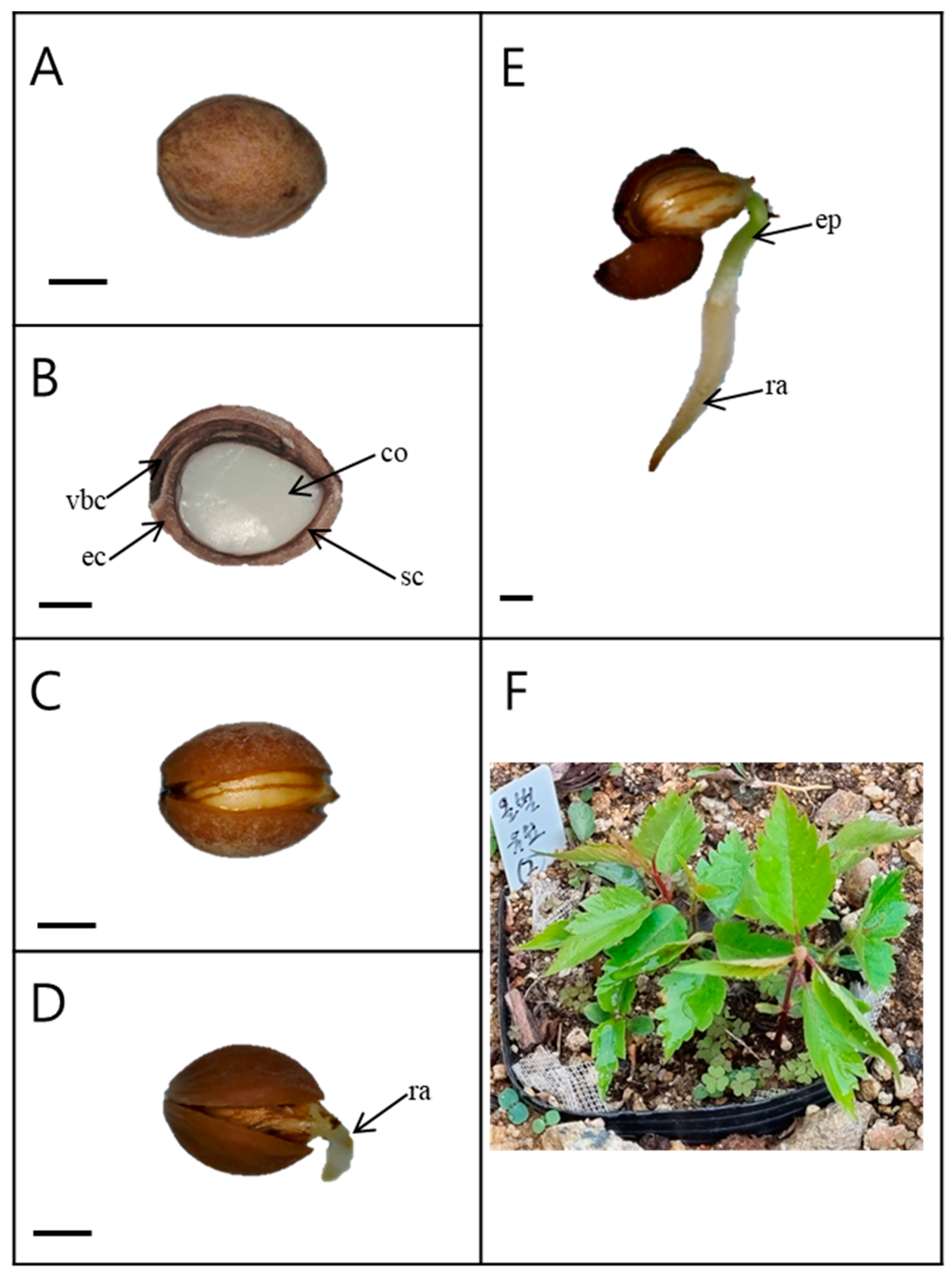

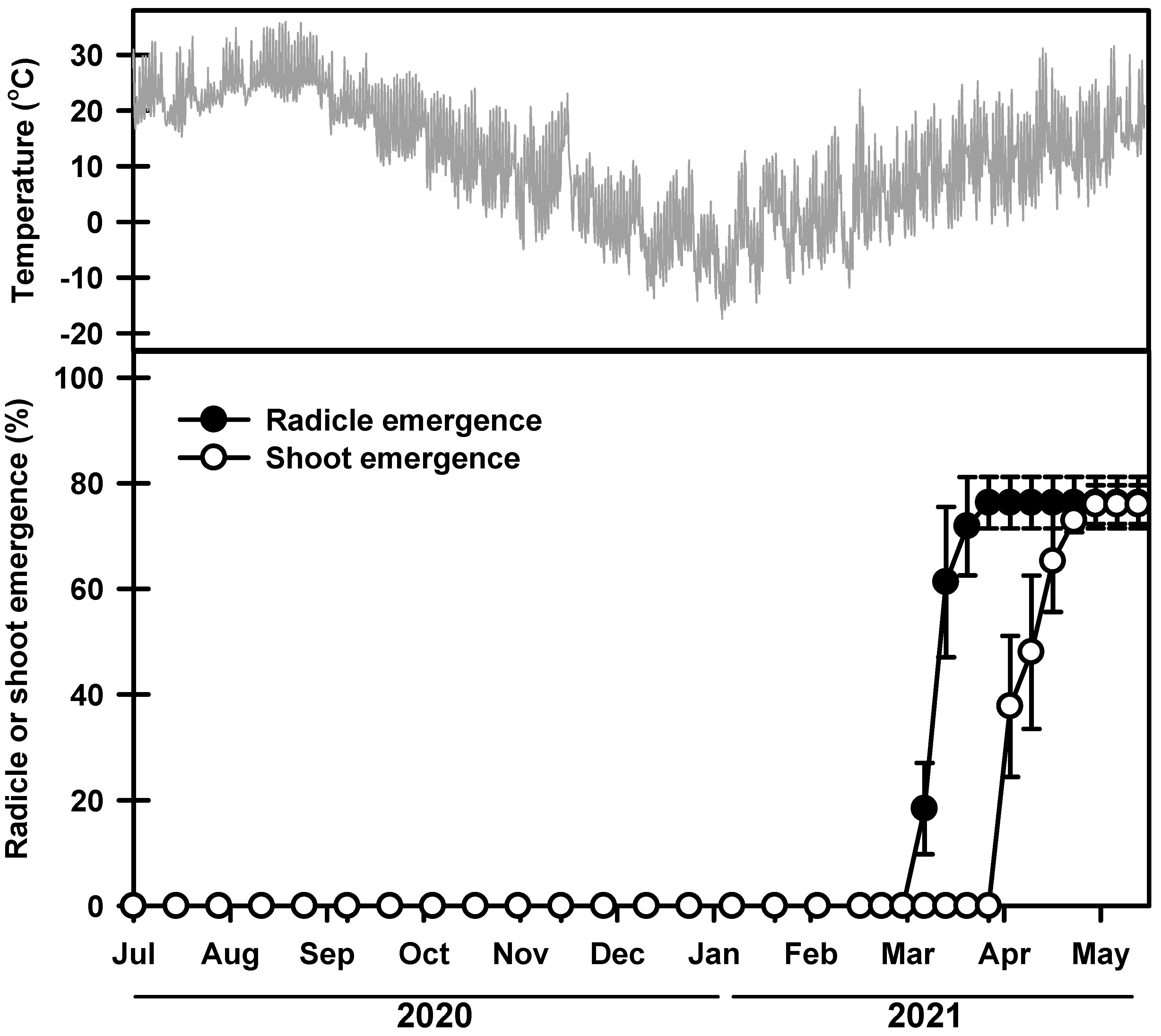
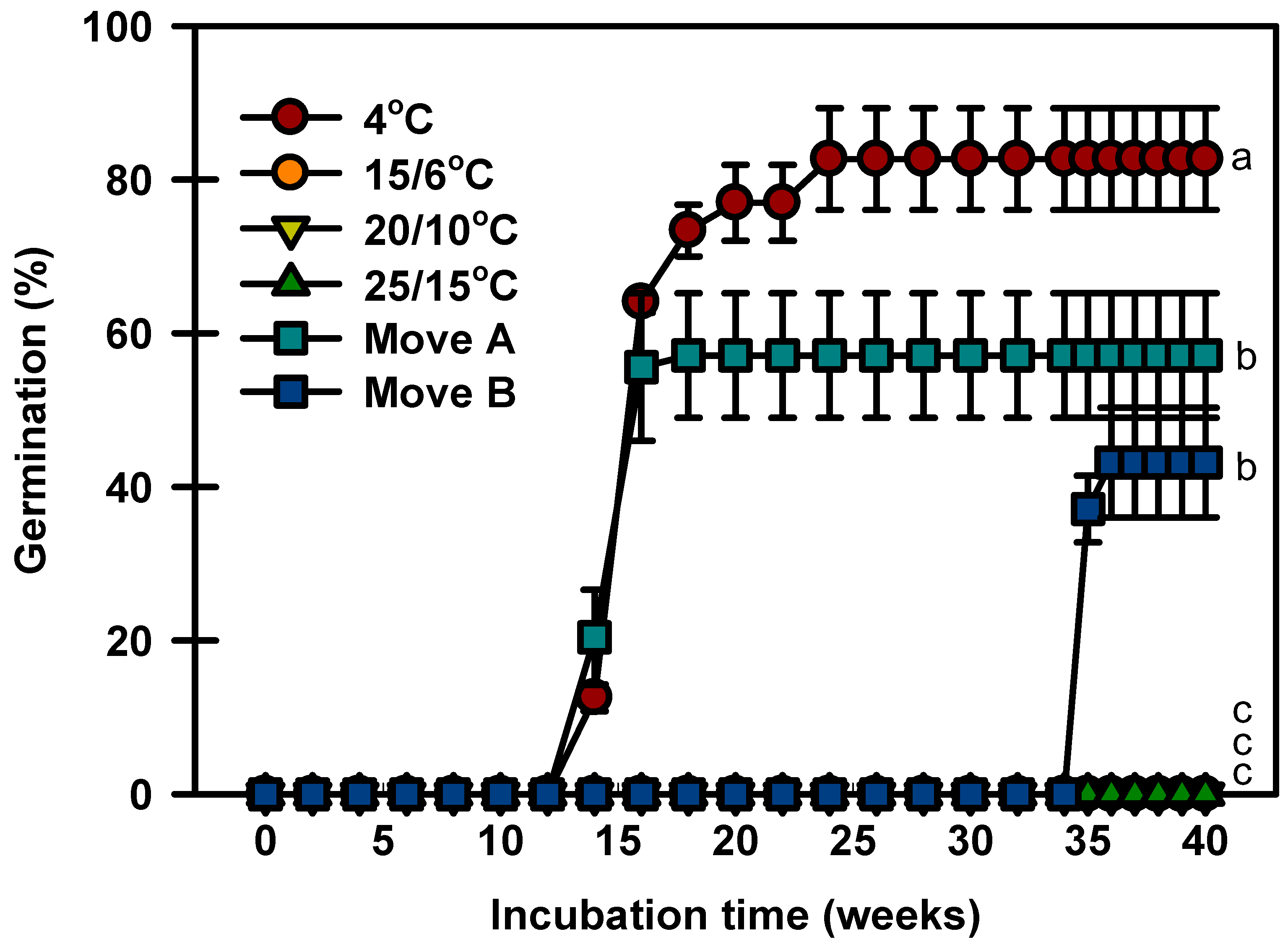
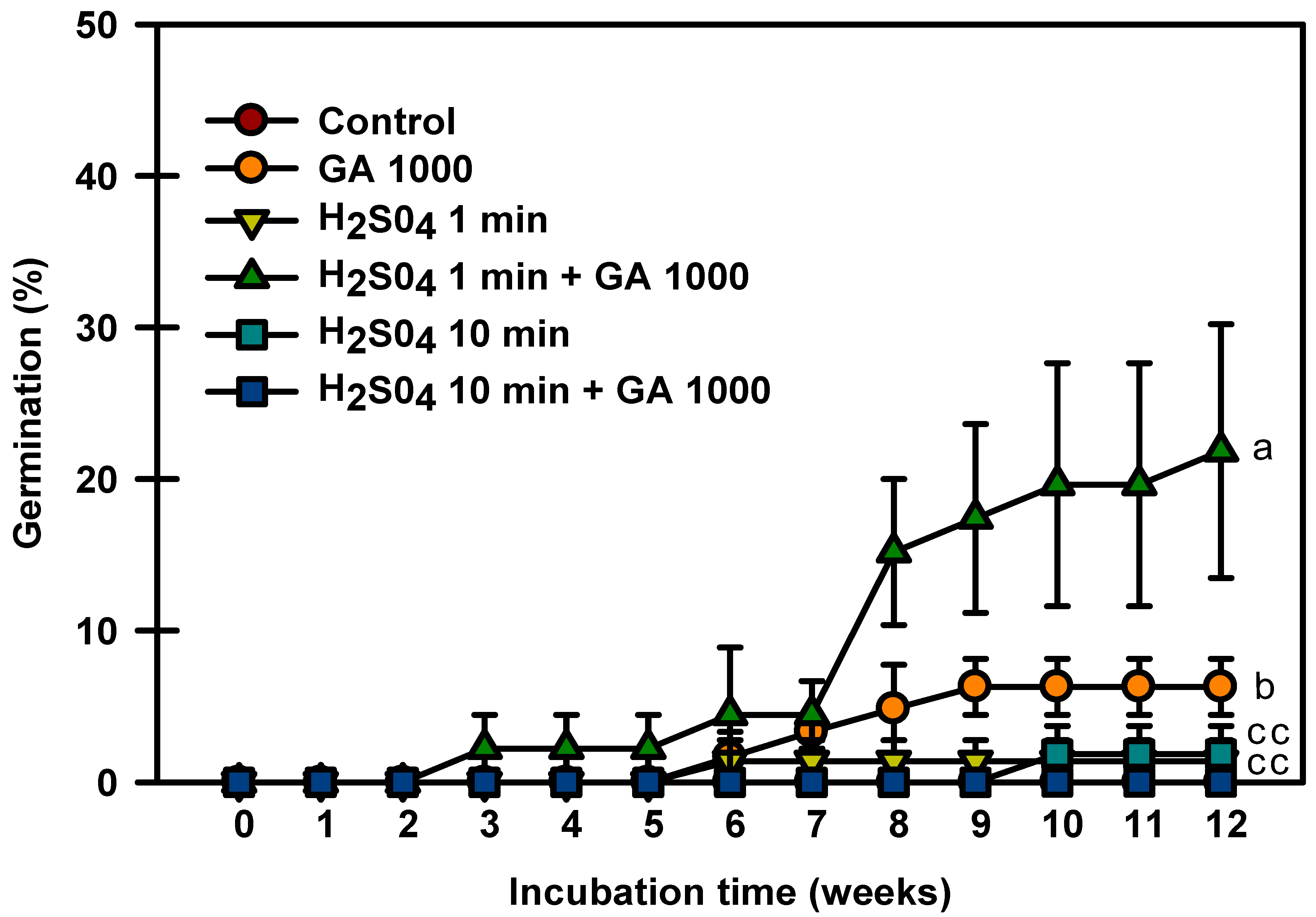

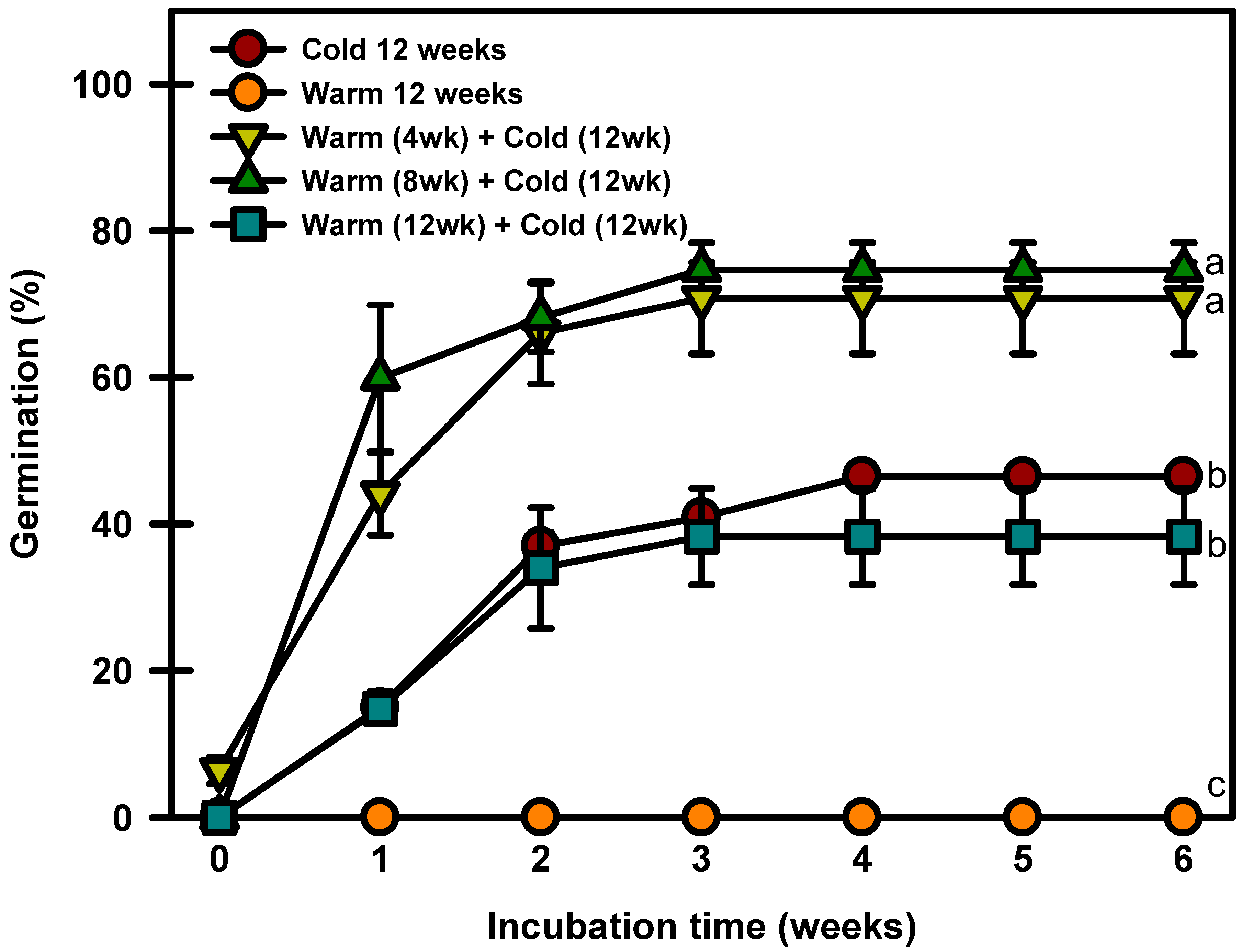
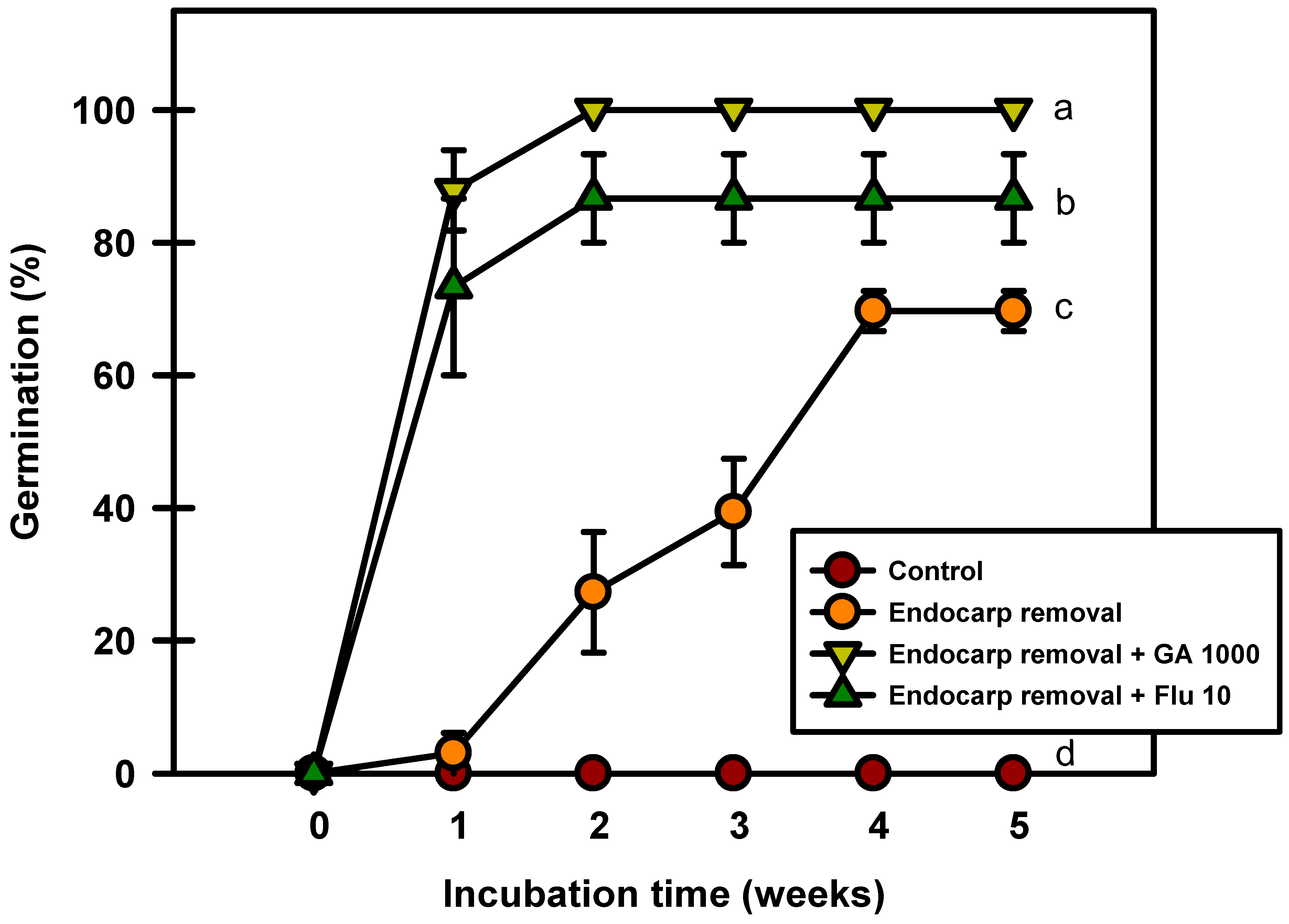
| Scientific Name | Common Name | Collection Location | Collection Date | Length (mm) | Width (mm) | 100 Seed Weight (g) |
|---|---|---|---|---|---|---|
| Prunus spachiana (Lavallée ex Ed.Otto) Kitam. f. ascendens (Makino) Kitam | Wild-spring cherry | Living collection from Korea National Arboretum | 29 June 2019 | 7.11 ± 0.096 z | 5.52 ± 0.073 | 8.87 ± 0.049 y |
| 8 June 2020 | - x | - | - |
Disclaimer/Publisher’s Note: The statements, opinions and data contained in all publications are solely those of the individual author(s) and contributor(s) and not of MDPI and/or the editor(s). MDPI and/or the editor(s) disclaim responsibility for any injury to people or property resulting from any ideas, methods, instructions or products referred to in the content. |
© 2024 by the authors. Licensee MDPI, Basel, Switzerland. This article is an open access article distributed under the terms and conditions of the Creative Commons Attribution (CC BY) license (https://creativecommons.org/licenses/by/4.0/).
Share and Cite
Kim, G.M.; Ko, C.H.; Chung, J.M.; Kwon, H.C.; Rhie, Y.H.; Lee, S.Y. Seed Dormancy Class and Germination Characteristics of Prunus spachiana (Lavallée ex Ed.Otto) Kitam. f. ascendens (Makino) Kitam Native to the Korean Peninsula. Plants 2024, 13, 502. https://doi.org/10.3390/plants13040502
Kim GM, Ko CH, Chung JM, Kwon HC, Rhie YH, Lee SY. Seed Dormancy Class and Germination Characteristics of Prunus spachiana (Lavallée ex Ed.Otto) Kitam. f. ascendens (Makino) Kitam Native to the Korean Peninsula. Plants. 2024; 13(4):502. https://doi.org/10.3390/plants13040502
Chicago/Turabian StyleKim, Gun Mo, Chung Ho Ko, Jae Min Chung, Hak Cheol Kwon, Yong Ha Rhie, and Seung Youn Lee. 2024. "Seed Dormancy Class and Germination Characteristics of Prunus spachiana (Lavallée ex Ed.Otto) Kitam. f. ascendens (Makino) Kitam Native to the Korean Peninsula" Plants 13, no. 4: 502. https://doi.org/10.3390/plants13040502
APA StyleKim, G. M., Ko, C. H., Chung, J. M., Kwon, H. C., Rhie, Y. H., & Lee, S. Y. (2024). Seed Dormancy Class and Germination Characteristics of Prunus spachiana (Lavallée ex Ed.Otto) Kitam. f. ascendens (Makino) Kitam Native to the Korean Peninsula. Plants, 13(4), 502. https://doi.org/10.3390/plants13040502








